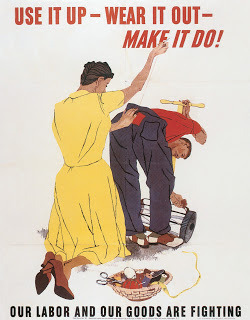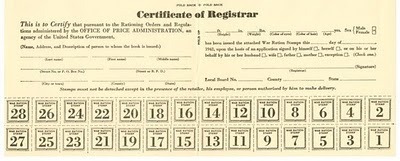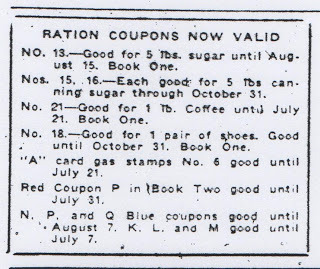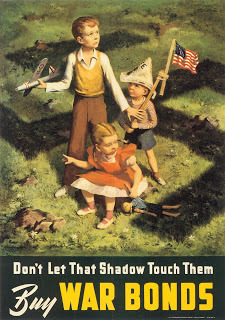Sarah Sundin's Blog, page 442
February 5, 2013
Today in World War II History
 70 Years Ago—Feb. 5, 1943: Nazis begin liquidating Bialystok ghetto; 1000 Jews killed, 10,000 sent to Treblinka.
70 Years Ago—Feb. 5, 1943: Nazis begin liquidating Bialystok ghetto; 1000 Jews killed, 10,000 sent to Treblinka.
Published on February 05, 2013 01:00
February 4, 2013
Make It Do - Shoe Rationing in World War II
 During World War II, many items were rationed in the United States, including shoes.
During World War II, many items were rationed in the United States, including shoes.Why Shoes?
Due to the serious rubber shortage (Make It Do - Tire Rationing in World War II), footwear made of rubber or with rubber soles was rationed or unavailable. Also, the military had a high need for leather, not just for shoes and combat boots but for those popular leather flight jackets. As a result, civilians made do with less.
Rationing of Rubber Footwear
Starting September 30, 1942, men’s rubber boots and rubber work shoes were placed under rationing. To obtain a new pair, a man had to apply to the local ration board, prove he needed the shoes for essential industry—not for sport—and turn in the old pair. Galoshes and overshoes were not rationed because they used less crude rubber, but sportsmen couldn’t get boots, and sneakers were no longer produced.

Shoe Rationing
On February 7, 1943, the United States instituted rationing of leather shoes. Each man, woman, and child could purchase up to three pairs of leather shoes a year, using designated stamps in War Ration Book One, and later in Books Three and Four. To simplify the system, only six shades of leather were produced. However, the supply of leather continued to decrease. On March 20, 1944, the ration was reduced to two pairs of leather shoes per year. Shoe rationing continued until October 30, 1945.
 Exceptions
ExceptionsThe strict rule that the ration stamp had to be torn from the book in the presence of the retailer was lifted for catalog purchases. If you wanted an extra pair of shoes, you had to fill out a long application at the ration board, listing every pair of footwear you owned, and explaining why another pair was essential for your occupation and why another pair was required to prevent serious hardship.
 What about Children?
What about Children?No exceptions were made for children and their rapidly growing feet. Families pooled their stamps, and adults made do with fewer shoes to provide for their children’s needs. However, pediatricians and podiatrists complained publicly that shoe rationing would produce a generation of “foot cripples.”
Making Do
To make do with less, people took care of the footwear they already owned, keeping rubber boots clean, dry, and away from excess heat or cold, and repairing shoes and boots whenever possible. Shoes made of fabric, such as espadrilles, were not rationed and became fashionable. Women also turned to fabric purses and belts.
Some people did not make do. Theft and black market profiteering were a continuing problem. For example, on May 3, 1944, a man was arrested in Pittsburg, California for stealing seven pairs of shoes from a shipment. The June 8, 1944 issue of the Antioch Ledger reported his sentence—six months or $500.
How would you do with only two or three new pairs of shoes a year? Try not to hyperventilate.
Published on February 04, 2013 02:00
Today in World War II History
 70 Years Ago—Feb. 4, 1943: Gen. Bernard Montgomery’s British Eighth Army crosses from Libya into Tunisia. European Theater of Operations (ETO) branches into North African Theater of Operations (NATO) in North Africa and Mediterranean under Gen. Dwight Eisenhower and ETO (UK, Iceland, continental Europe except Spain and Italy) under Gen. Frank Andrews.
70 Years Ago—Feb. 4, 1943: Gen. Bernard Montgomery’s British Eighth Army crosses from Libya into Tunisia. European Theater of Operations (ETO) branches into North African Theater of Operations (NATO) in North Africa and Mediterranean under Gen. Dwight Eisenhower and ETO (UK, Iceland, continental Europe except Spain and Italy) under Gen. Frank Andrews.
Published on February 04, 2013 01:00
February 3, 2013
Today in World War II History
 70 Years Ago—Feb. 3, 1943: US transport Dorchester sunk by U-223 off Greenland, 675/900 killed; four chaplains of different faiths give away their lifebelts and go down with the ship. Britain allows 5000 Bulgarian Jews, mostly children, to emigrate to Palestine.
70 Years Ago—Feb. 3, 1943: US transport Dorchester sunk by U-223 off Greenland, 675/900 killed; four chaplains of different faiths give away their lifebelts and go down with the ship. Britain allows 5000 Bulgarian Jews, mostly children, to emigrate to Palestine.
Published on February 03, 2013 01:00
February 2, 2013
Today in World War II History
 70 Years Ago—Feb. 2, 1943: German Sixth Army surrenders to Soviets in Stalingrad—91,000 prisoners taken, of whom only 5000 survive the war.Australians counterattack at Wau, New Guinea.
70 Years Ago—Feb. 2, 1943: German Sixth Army surrenders to Soviets in Stalingrad—91,000 prisoners taken, of whom only 5000 survive the war.Australians counterattack at Wau, New Guinea.
Published on February 02, 2013 01:00
February 1, 2013
Today in World War II History
 Insignia of 442nd Regimental Combat Team 70 Years Ago—Feb. 1, 1943: Japanese begin evacuation of 13,000 troops from Guadalcanal. Mussolini dismisses Gen. Ugo Cavallero as head of Italian armed forces (Comando Supremo), replaces him with Gen. Vittorio Ambrosio. US forms 442nd Regimental Combat Team for Japanese-American soldiers, including internees.
Insignia of 442nd Regimental Combat Team 70 Years Ago—Feb. 1, 1943: Japanese begin evacuation of 13,000 troops from Guadalcanal. Mussolini dismisses Gen. Ugo Cavallero as head of Italian armed forces (Comando Supremo), replaces him with Gen. Vittorio Ambrosio. US forms 442nd Regimental Combat Team for Japanese-American soldiers, including internees.
Published on February 01, 2013 01:00
January 31, 2013
Book Beat - Poison by Jordyn Redwood
 Health care professionals often wince at medical inaccuracies in novels, but I knew I wouldn't have that problem with Jordyn Redwood's novels. I became acquainted with Jordyn when she started Redwood's Medical Edge, a blog devoted to helping fiction writers get medical facts straight for their stories. Her seventeen years' experience in critical care and ER nursing, and her careful eye for detail shine on her blog - and in her newest novel,
Poison
.
Health care professionals often wince at medical inaccuracies in novels, but I knew I wouldn't have that problem with Jordyn Redwood's novels. I became acquainted with Jordyn when she started Redwood's Medical Edge, a blog devoted to helping fiction writers get medical facts straight for their stories. Her seventeen years' experience in critical care and ER nursing, and her careful eye for detail shine on her blog - and in her newest novel,
Poison
.In Poison , Keelyn Blake thinks she's put her past behind her. Until she's approached by a man claiming to be Lucent - the name of the hallucination that induced Keelyn's stepfather to kill most of her family. Now a string of murders strike people associated with that horrid day. Keelyn and the one man who refuses to give up on her trace a baffling trail of evidence toward the killer.
Intense and gripping. From the first swallow, Poison ’s potent brew of medical, police, and psychological thrills won’t leave your system. The only antidote is to finish the book—which you’ll do in record time.
Published on January 31, 2013 02:00
Today in World War II History
 70 Years Ago—Jan. 31, 1943: Admiral Karl Dönitz takes command of German Navy. Soviets take southern pocket in Stalingrad; Gen. Friedrich Paulus taken prisoner. Germans take Faïd and Pichon Passes in Tunisia.
70 Years Ago—Jan. 31, 1943: Admiral Karl Dönitz takes command of German Navy. Soviets take southern pocket in Stalingrad; Gen. Friedrich Paulus taken prisoner. Germans take Faïd and Pichon Passes in Tunisia.
Published on January 31, 2013 01:00
January 30, 2013
Today in World War II History
 70 Years Ago—Jan. 30, 1943: RAF’s first daylight raid over Berlin, timed to interrupt Goering and Goebbel’s speeches on tenth anniversary of Reich. The Milice formed in Vichy France under Joseph Darnand to counter the Resistance. Australians defeat Japanese at Wau, New Guinea.
70 Years Ago—Jan. 30, 1943: RAF’s first daylight raid over Berlin, timed to interrupt Goering and Goebbel’s speeches on tenth anniversary of Reich. The Milice formed in Vichy France under Joseph Darnand to counter the Resistance. Australians defeat Japanese at Wau, New Guinea.
Published on January 30, 2013 01:00
January 29, 2013
Giveaway Winner - The Lesson
 Thank you so much to those of you entered the giveaway of Suzanne Woods Fisher's
The
Lesson
. And special thanks to Suzanne for donating a copy! To read more about this fun and touching book, please see my feature.
Thank you so much to those of you entered the giveaway of Suzanne Woods Fisher's
The
Lesson
. And special thanks to Suzanne for donating a copy! To read more about this fun and touching book, please see my feature.The winner of The Lesson is Noelle! Noelle, I'll send you a direct email.
Published on January 29, 2013 14:12



